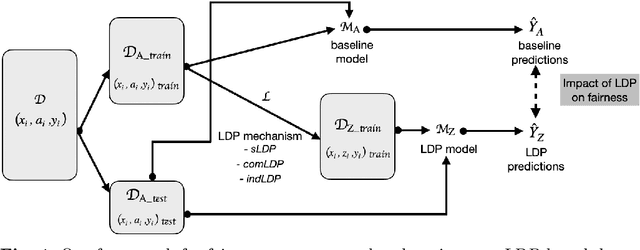Ghassen Ben Brahim
On the Impact of Multi-dimensional Local Differential Privacy on Fairness
Dec 08, 2023



Abstract:Automated decision systems are increasingly used to make consequential decisions in people's lives. Due to the sensitivity of the manipulated data as well as the resulting decisions, several ethical concerns need to be addressed for the appropriate use of such technologies, in particular, fairness and privacy. Unlike previous work, which focused on centralized differential privacy (DP) or local DP (LDP) for a single sensitive attribute, in this paper, we examine the impact of LDP in the presence of several sensitive attributes (i.e., multi-dimensional data) on fairness. Detailed empirical analysis on synthetic and benchmark datasets revealed very relevant observations. In particular, (1) multi-dimensional LDP is an efficient approach to reduce disparity, (2) the multi-dimensional approach of LDP (independent vs. combined) matters only at low privacy guarantees, and (3) the outcome Y distribution has an important effect on which group is more sensitive to the obfuscation. Last, we summarize our findings in the form of recommendations to guide practitioners in adopting effective privacy-preserving practices while maintaining fairness and utility in ML applications.
Dates Fruit Disease Recognition using Machine Learning
Nov 17, 2023



Abstract:Many countries such as Saudi Arabia, Morocco and Tunisia are among the top exporters and consumers of palm date fruits. Date fruit production plays a major role in the economies of the date fruit exporting countries. Date fruits are susceptible to disease just like any fruit and early detection and intervention can end up saving the produce. However, with the vast farming lands, it is nearly impossible for farmers to observe date trees on a frequent basis for early disease detection. In addition, even with human observation the process is prone to human error and increases the date fruit cost. With the recent advances in computer vision, machine learning, drone technology, and other technologies; an integrated solution can be proposed for the automatic detection of date fruit disease. In this paper, a hybrid features based method with the standard classifiers is proposed based on the extraction of L*a*b color features, statistical features, and Discrete Wavelet Transform (DWT) texture features for the early detection and classification of date fruit disease. A dataset was developed for this work consisting of 871 images divided into the following classes; Healthy date, Initial stage of disease, Malnourished date, and Parasite infected. The extracted features were input to common classifiers such as the Random Forest (RF), Multilayer Perceptron (MLP), Na\"ive Bayes (NB), and Fuzzy Decision Trees (FDT). The highest average accuracy was achieved when combining the L*a*b, Statistical, and DWT Features.
 Add to Chrome
Add to Chrome Add to Firefox
Add to Firefox Add to Edge
Add to Edge